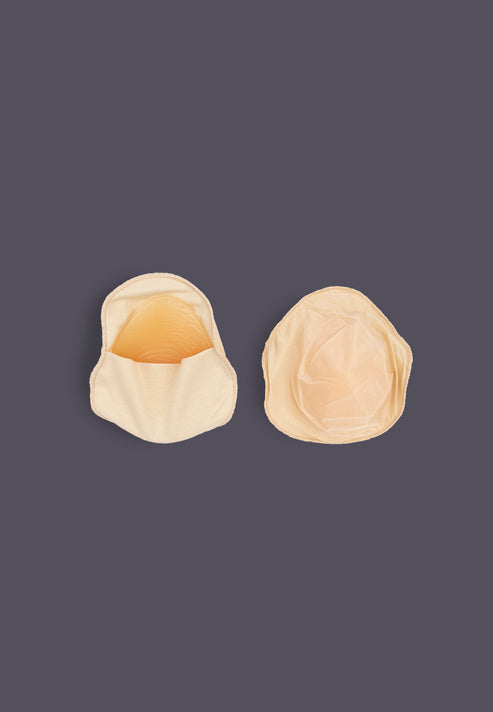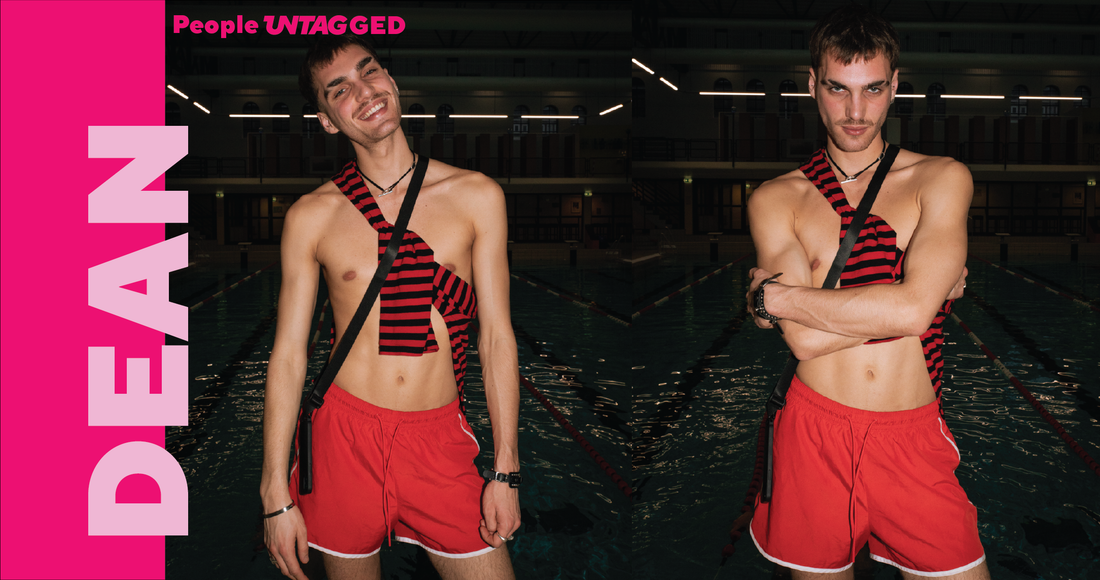For the People UNTAGGED -series, we talk to people about their gender identity. By sharing their stories in a positive way, we want to inspire others, within the LGBTQIA+ community and beyond.
For this edition we spoke with Dean, who has recently graduated from AMFI in branding. For his graduation project, he developed a campaign for UNTAG about queer sports titled UNTAG MOVE. Read more about his inspiration behind this project and how sports can boost self-confidence.
Hey Dean, so great that you want to tell us more about your project UNTAG MOVE! Could you start by introducing yourself?
Certainly, my name is Dean Sanders, 24 years old. I’m from Groessen, a small town close to Arnhem. At the moment I am graduating at the AMFI (Amsterdam Fashion Institute). Besides that I work for Numéro magazine. I also engage a lot in sports. Besides fashion, sports is an important part of my life.
Can you tell us a little more about how sports are present in your life?
As a kid I started with athletics. I got better and better at it. When I was about seventeen I participated in the Dutch national championships in the decathlon. I’ve always found athletics to be a very pleasant type of sport. Also because it’s a sport where men and women train together. In training, everyone has their own strengths because a sprinter has a very different physique than a shot putter, and a long-distance runner is quite different from a high jumper. Because everyone has their own strengths, many different types are welcomed. Later in life, I went to the sports academy: CIOS in Arnhem. There, I completed the training to become a movement therapist. However, after graduating, I realized that I didn't want to make sports my profession. It just didn't make me happy. This feeling was also because I didn't always feel very comfortable at the sports academy. I believe I was one of the few homosexual men at my school.
What was that period like for you? Were you openly gay at that time?
I really came out at my sixteenth. So when I started school at CIOS I was already gay. I never really spoke out about it. But I can clearly remember that someone at the introduction camp said “if someone in this tent is gay, I will beat him to pieces”. That’s when I realized I really had to be careful. And it remained difficult during my studies. In the changing rooms I would always face the wall so nobody would feel uncomfortable. I also felt I constantly had to prove myself. The teacher that that I couldn’t fight or play rugby because of my sexuality. But it always kind of gave me a kick to prove them wrong. People have a prejudice about me, and through my achievements I can destroy that prejudice.
Eventually, when graduating at the sports academy, I really didn’t feel at home anymore. Also because I couldn’t express my creative side. Nowadays I do exercise in my free time, which is purely for fun. I don’t have to achieve anything with it, and it’s good for my mental health.
That’s nice, right? And how did you end up at AMFI after the sports academy?
Already at the sports academy I felt I missed something creative. At AMFI I saw the branding programme, and that was exactly what I was looking for. It actually covers all facets of the fashion industry and not just design or marketing.
And now you’re working on your graduation project UNTAG MOVE, what’s that about?
I really wanted to do a project where fashion and sports come together. It felt like a full circle moment where I can really do something for the queer community. Especially because I myself encountered many challenging situations as an athlete, and I also felt unsafe. I started by doing research at different sports arenas. There I spoke to many people to discover what exactly the issue is. For my studies it’s really important that you can link a brand to your project, and that’s how I found UNTAG. This is exactly a company that has developed a product that solves a problem without slapping on a thick layer of rainbow branding. It simply is product, problem, solution. I found that to be very powerful. Then I did more research into Pride and sports. This research showed how important it is to show queer bodies in sports arenas. By creating this visibility I hope to lower the barrier for other people: if I can do it, why couldn’t you?
What kind of problems did you identify when you were conducting research among athletes?
One problem was simply the fear of the gym itself. This is true for everyone, actually, just as much for cisgender heterosexual men as for transgender individuals. However, for a transgender person, there's an entirely different aspect involved, because, for instance, a transgender man at the beginning of his transition has a quite visible identity. This can lead to conflicts or make you feel overly observed. The fear that prevents people from feeling comfortable in the sports facility was the biggest issue. Additionally, I noticed that clothing can play a role in this, allowing you to feel more comfortable in that sports space.
In UNTAG MOVE, three athletes are in the spotlight. Can you tell us a little more about who they are and what they do?
Yes, first up there is Jay Muller who is a boxer. I once saw him at a presentation in Queer Gym, about queer individuals and sports arenas. He really wants to fight at a high level. His gender identity is preventing him from doing so. He finds himself in a kind of gray area, which means he can’t really participate anywhere. He told me about Boogieland, where 50% of the boxing school are women.
Then there is Stef, who swims. He has done ballet at a very high level. Now he teaches spinning classes at Rocycle. For his classes he always dresses in a crop top and short sports leggings. What other people think of him doesn’t interest him. At the start of class people have a clear prejudice about him, but at the end they always have a lot of respect for him. With him I spoke a lot about the fact that you constantly have to prove yourself.
And then there is Tan, the pole dancer. What I found so interesting about Tan, is that they are non-binary but also embrace their masculinity and femininity. This combination of playing with gender, the feminine moves, but the masculine presentation, was a perfect match.
And when we look at the fashion in UNTAG MOVE, we see a lot of black and pink. How did that come to be?
Pink and red is my favorite color combination. It also has to do with the current culture. Barbie just came out, which did inspire me. I just really did not want to use a rainbow, so I came up with the colors purple, blue, red, pink. These colors are queer colors to me. I found it a good message to dress these individuals in pink, because it’s an eye-catching color.
Sounds good. Earlier you mentioned you actually missed a rolemodel when you were at the academy. Are there any people that you admire nowadays?
When it comes to queer athletes there unfortunately aren’t that many of them. But there is an intersex athlete that I looked at a lot: Caster Semenya. She was taken from the competition because she naturally had too much testosterone. Her story was super inspiring to me.
Seeing that you have a background in fashion, are there things that catch your eye in fashion when it comes to gender identity?
One notices more attention for flamboyant styles, I think that’s super interesting. Men more often wear nail polish, or a higher heel at times, or a skirt. Regardless of whether you are a hetero, gay, or trans man. I find that a very nice development. Aside from that, a lot is changing in the world of fashion. I myself started modeling at fifteen and also was on Holland's Next Top Model. When I came out at sixteen I was told that I shouldn’t show that I was gay. I really thought that was a problem. Now I’m noticing that models are being booked more for who they are. Although this has a bit of a hype, it is a positive one. I think it’s a lot easier to be a queer model nowadays than back when I started out. I was really unhappy because I couldn’t be myself. I constantly had to pretend to be a straight person.
What helped you back then to feel good about who you are?
Sports! And that actually completes the circle. For me sport was always something I could fall back on. Sport has given me a lot of confidence at a mental level. It’s always shown me that I am just as good as anybody else. I find it really cool to prove myself with that. Purely with my own strength.
Are there any tips or tricks you want to give to people that can help them feel comfortable in the gym?
Absolutely. I think it’s important to focus on yourself. Besides that it helps to create a good playlist, with music that helps you feel comfortable and confident. For me that’s simply Britney and Madonna. It’s also good to be confident in what you’re doing. That when you’re at the gym you know which exercises to do. I’ve never really felt that uncomfortable in the gym due to my sports background, so I know exactly what I’m doing. Besides that there are so many sport groups that are queer friendly. Really for any sport: tennis, hockey, soccer, there is a queer group for all of it. So if you don’t like going to a public sports facility, there are always other options. I’m really happy it exists, so use it!
Is there a message you would want to give to people in the community?
If you find yourself in a position where you don’t know where you stand, just go and have a coffee with some queer friends. If you don’t have those, download Tinder and put in your bio ‘looking for friends, I need someone to talk to’. Really try to find people who you can talk to. It can be lonely at times, so try and find like-minded people around you!




